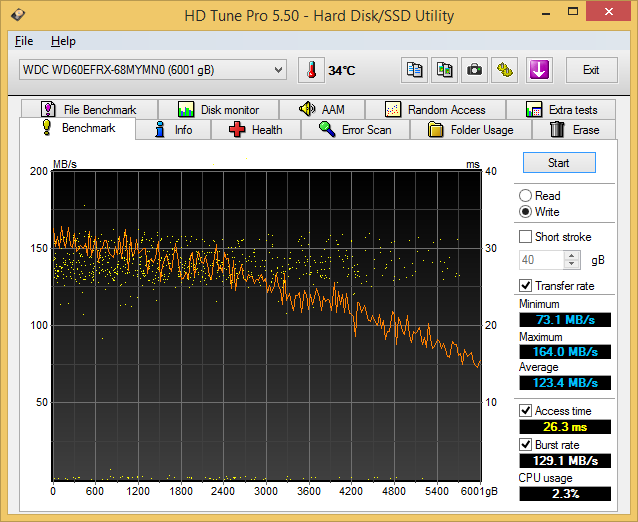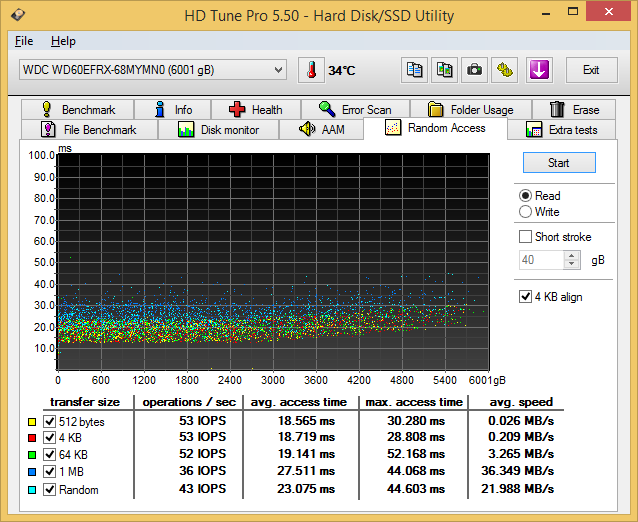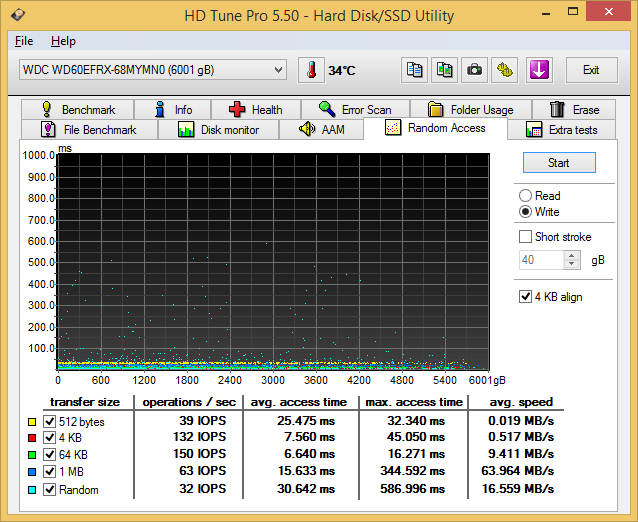6 TB NAS Drives: WD Red, Seagate Enterprise Capacity and HGST Ultrastar He6 Face-Off
by Ganesh T S on July 21, 2014 11:00 AM ESTPerformance - Raw Drives
Prior to evaluating the performance of the drives in a NAS environment, we wanted to check up on the best-case performance of the drives by connecting them directly to a SATA 6 Gbps port. Using HD Tune Pro 5.50, we ran a number of tests on the raw drives. The following screenshots present the results for the various drives in an easy-to-compare manner.
Sequential Reads

The Seagate Enterprise Capacity drive, as expected, leads the benchmark numbers with an average transfer rate of around 171 MBps. The HGST unit (142 MBps) performs better than the WD Red (126 MBps) in terms of raw data transfer rates, thanks to the higher rotational speed. The burst rate of the Seagate drive is also higher. In effect, the higher amount of cache memory on the Seagate drive helps it to perform well in this test.
Sequential Writes

A similar scenario plays out in the sequential write benchmarks. The Seagate drive leads the pack with an average transfer rate of 168 MBps followed by the HGST one at 139 MBps. The WD Red's 123 MBps is the slowest of the lot, but these results are foregone conclusions due to the lower rotational speeds in the Red.
Random Reads

In the random read benchmarks, the HGST and Seagate drives perform fairly similar to each other in terms of IOPS as well as average access time.
Random Writes

The differences between the enterprise-class drives and the consumer / SOHO NAS drives is even more pronounced in the random write benchmark numbers. However, the most interesting aspect here is that the HGST Ultrastar He6 wins out on the IOPS for 512B transfers due to its sector size. Otherwise, the familiar scenario that we observed in the previous subsections play out here too.
Miscellaneous Reads

HD Tune Pro also includes a suite of miscellaneous tests such as random seeks and sequential accesses in different segments of the hard disk platters. The numbers above show the HGST and Seagate drives matched much more evenly. The cache effects are also visible in the final graph.
Miscellaneous Writes

Similar to the previous sub-section, we find that the Seagate and HGST drives quite evenly matched in most of the tests. The HGST drive does exhibit some weird behaviour with the burst rate test and the Seagate one with the 8 MB random seek tests, while the Red is consistent across all of them without being exceptional.
We now have an idea of the standalone performance of the three drives being considered today. In the next section, we will take a look at the performance of these drives when subject to access from a single client - as a DAS as well as a NAS drive.










83 Comments
View All Comments
Wixman666 - Tuesday, July 22, 2014 - link
The WD Green and other drives fail more often because they are not intended for NAS use. They lack the anti-vibration mechanism, so they shake apart.anandtech_user01 - Monday, July 21, 2014 - link
Given my own previous experiences, I wouldn't trust high density 3.5" drives from any manufacturer period. Of course, lots of other people do (or somehow feel forced to). As for WD RED, they can be better than the competition in respect to being able to switch off the head-parking every 10 seconds (with wdidle3.exe DOS utility). Wheras I've got 2 Seagate Momentus 7200.2/4 and that's impossible with them. Looking at the specs for the 2.5" RED it's pretty much just a re-branded WD Black from the previous year. And those ones have been out for a few years, and are reliable / do have a good reputation. Wheras I've heard that the 3.5" RED something more like a re-worked / tweaked 3.5" WD Green. Not so sure about those ones.kmi187 - Monday, July 21, 2014 - link
Anecdotal evidence, while it should not be discarded, is rather irrelevant since the scale is rather low. Now if you look at some statistics from data-centers it shows seagate as a clear winner when it come to failure rates. In other words, they aren't doing too well.This data is much more reliable since it's data from a lot of hard drives, so it paints a much clearer picture.
I build custom pc's for a computer store and it's just not fun when you have kickass system that went out the door and 2 months later you have to tell the client, yeah sorry man but the drive died, we are going to have to reinstall your pc. If that starts to happen on regular basis, you know you have to look for alternatives.
romrunning - Monday, July 21, 2014 - link
Why wouldn't you build w/SSDs as your base drive, and only use spinning disks as secondary storage? It would seem that you would have better reliability that way.asmian - Monday, July 21, 2014 - link
Agree! It clearly isn't a "kickass" custom system if there's no SSD as boot drive. I pity these customers if they are being sold something as "special" without that as a basic building block these days. :( Please tell us where you work so we can avoid your store.erple2 - Tuesday, July 22, 2014 - link
Because managing two disks is a total waste of time and resources. If you're already going to a shop to have a machine built for you, then you've realized that your time is worth more to you than the inconvenience or rolling your own machine. Therefore, it stands to reason that you would also not want to be bothered with having to juggle installations to ssd vs. HDD. I have a setup like that in a laptop, and I hate having to figure out what applications I should put on the ssd vs the HDD. Just give me something that works. That and my time is worth far more than the cost spent trying to juggle applications on and off the ssd when it fills up.That having been said, ssd is pretty cheap now, so I'm not sure why you wouldn't put in a 500 gb to 1 tb ssd in a higher end build.
Samus - Monday, July 21, 2014 - link
I actually haven't had a drive from Seagate, WD or Hitachi fail in years. The last one was a 7200.10 1.5TB (~2008)I have more WD Red's in deployment than any other drive and they've all been great. However, the largest capacity I've rolled out are 2TB models.
iLovefloss - Monday, July 21, 2014 - link
Their older Barracuda drivers sure did.http://blog.backblaze.com/2014/01/21/what-hard-dri...
Of course, they gotten better.
http://www.hardware.fr/articles/920-6/disques-durs...
Still, no matter how you look at it, those "Green" drives tend to fail more often than their other counterparts.
cm2187 - Tuesday, July 22, 2014 - link
Same here. A bunch of 4TB Red and never managed to make them work in a hardware RAID array (LSI and Adaptec). Same symptoms as in the article. Drive marked as failed in the array but works well as standalone. Still had some problems though much less in a soft array (synology). Hitachi desktop drives behave much better in a hardware RAID.LoneWolf15 - Friday, July 25, 2014 - link
I've been running Reds (mix of 2TB and 3TB, as I'm slowly migrating capacity) in an HP SmartArray P222 in an HP Microserver Gen8 for some time now. 6TB RAID-5 array and no failures.I will admit, I haven't tried the 4TB models for RAID, but do have one in a USB3 MacAlly external enclosure for backing up the box (Server 2012R2 Standard).